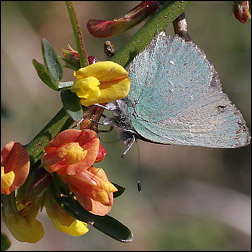California is in a state of “Extreme Drought”, with 2014 being the driest year since 1895, 119 years ago! But, in spite of this disastrous condition, one can still observe some native wildflowers in bloom on More Mesa. For example, Deerweed, which normally blooms from March to October, has been in flower constantly for more than a year. Heavily populating the east-west coastal trail, it most likely prospers in this severe drought because it is a plant that is able to survive on the moisture left behind from the many fogs that visit us in spring and summer.

Deerweed, also known as California Broom, is not only resourceful, but has a fascinating adaptation. This dainty, native Chaparral plant has a clever way of attracting pollinators to the correct flowers. Beginning yellow, the flowers turn red after pollination. Bees cannot see the color red, so it keeps them from wasting time on flowers that have already been visited.
In addition to the non-native honeybee, Deerweed flowers are pollinated by native bees in the Bombus, Hoplitus, Osmia, Agapostemon, Anthophora, Habropoda, and Anthidium genera. [1] Deerweed is pollinated by butterflies (nectar source), and also serves as a host plant to many species of butterfly larvae. Once the flowers have been pollinated, the resulting seeds provide food for birds and rodents. Lastly, per its name, deer feed on the plant, where they are found together.

